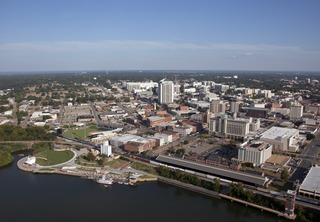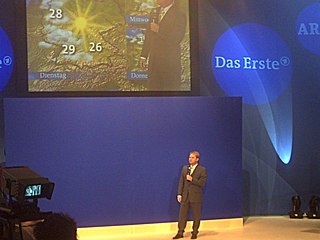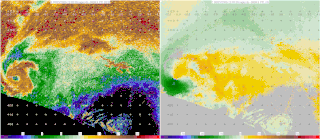
Montgomery is the capital city of the U.S. state of Alabama and the county seat of Montgomery County. Named for Continental Army Major General Richard Montgomery, it stands beside the Alabama River, on the coastal Plain of the Gulf of Mexico. The population was 200,603 at the 2020 census. It is now the third most populous city in the state, after Huntsville and Birmingham, and is the 128th most populous in the United States. The Montgomery Metropolitan Statistical Area's population in 2022 was 385,460; it is the fourth largest in the state and 142nd among United States metropolitan areas.

A thunderstorm, also known as an electrical storm or a lightning storm, is a storm characterized by the presence of lightning and its acoustic effect on the Earth's atmosphere, known as thunder. Relatively weak thunderstorms are sometimes called thundershowers. Thunderstorms occur in a type of cloud known as a cumulonimbus. They are usually accompanied by strong winds and often produce heavy rain and sometimes snow, sleet, or hail, but some thunderstorms produce little precipitation or no precipitation at all. Thunderstorms may line up in a series or become a rainband, known as a squall line. Strong or severe thunderstorms include some of the most dangerous weather phenomena, including large hail, strong winds, and tornadoes. Some of the most persistent severe thunderstorms, known as supercells, rotate as do cyclones. While most thunderstorms move with the mean wind flow through the layer of the troposphere that they occupy, vertical wind shear sometimes causes a deviation in their course at a right angle to the wind shear direction.

A meteorologist is a scientist who studies and works in the field of meteorology aiming to understand or predict Earth's atmospheric phenomena including the weather. Those who study meteorological phenomena are meteorologists in research, while those using mathematical models and knowledge to prepare daily weather forecasts are called weather forecasters or operational meteorologists.

A tornado warning is a public warning that is issued by weather forecasting agencies to an area in the direct path of a tornado, or a thunderstorm capable of producing one, and advises individuals in that area to take cover. Modern weather surveillance technology such as Doppler weather radar can detect rotation in a thunderstorm, allowing for early warning before a tornado develops. They are also commonly issued based on reported visual sighting of a tornado, funnel cloud, or wall cloud, typically from weather spotters or the public, but also law enforcement or local emergency management. When radar is unavailable or insufficient, such ground truth is crucial. In particular, a tornado can develop in a gap of radar coverage, of which there are several known in the United States.

A tornado watch is a severe weather watch product of the National Weather Service that is issued by national weather forecasting agencies when meteorological conditions are favorable for the development of severe thunderstorms capable of producing tornadoes. In addition to the potential for tornado development, thunderstorms that develop within the watch area may contain large hail, straight-line winds, intense rainfall and/or flooding that pose a similar damage risk as the attendant tornado threat. A tornado watch does not mean a tornado is active or will appear, just that favorable conditions increases the likelihood of such happening. A watch must not be confused with a tornado warning.

This article lists various tornado records. The most "extreme" tornado in recorded history was the Tri-State tornado, which spread through parts of Missouri, Illinois, and Indiana on March 18, 1925. It is considered an F5 on the Fujita Scale, holds records for longest path length at 219 miles (352 km), longest duration at about 3+1⁄2 hours, and it held the fastest forward speed for a significant tornado at 73 mph (117 km/h) anywhere on Earth until 2021. In addition, it is the deadliest single tornado in United States history with 695 fatalities. It was also the third most costly tornado in history at the time, when costs are normalized for wealth and inflation, it still ranks third today.

Thomas E. Skilling III is a former American television meteorologist. From 1978 to his retirement in 2024, he worked as a meteorologist at WGN-TV in Chicago.

A weather presenter is a person who presents the weather forecast daily on radio, television or internet news broadcasts.
James Max Spann Jr. is a television meteorologist and podcast host based in Birmingham, Alabama. He currently works for WBMA-LD, Birmingham's ABC affiliate. Spann has worked in the field since 1978. He is also the host of the podcast WeatherBrains which he started in 2006.
On February 19–20, 1884, one of the largest and most widespread tornado outbreaks in American history occurred over the Southeastern United States, known as the Enigma tornado outbreak due to the uncertain number of total tornadoes and fatalities. Nonetheless, an inspection of newspaper reports and governmental studies published in the aftermath reveals successive, long-tracked tornado families striking Alabama, Georgia, Illinois, Indiana, Kentucky, Mississippi, North Carolina, South Carolina, Tennessee and Virginia, with an estimation of at least 51—and possibly 60 or more—tornadoes.
Convective storm detection is the meteorological observation, and short-term prediction, of deep moist convection (DMC). DMC describes atmospheric conditions producing single or clusters of large vertical extension clouds ranging from cumulus congestus to cumulonimbus, the latter producing thunderstorms associated with lightning and thunder. Those two types of clouds can produce severe weather at the surface and aloft.

Robert H. "Bob" Johns was an American meteorologist specializing in severe convective storms and tornadoes.
On March 21–22, 1932, a deadly tornado outbreak struck the Midwestern and Southern United States. At least 38 tornadoes—including 27 deadly tornadoes and several long-lived tornado families—struck the Deep South, killing more than 330 people and injuring 2,141. Tornadoes affected areas from Mississippi north to Illinois and east to South Carolina, but Alabama was hardest hit, with 268 fatalities; the outbreak is considered to be the deadliest ever in Alabama, and among the worst ever in the United States, trailing only the Tri-State tornado outbreak in 1925, with 751 fatalities, and the Tupelo–Gainesville outbreak in 1936, with 454 fatalities. The 1932 outbreak is believed to have produced 10 violent tornadoes, eight of which occurred in Alabama alone.

The 1948 Tinker Air Force Base tornadoes were two tornadoes which struck Tinker Air Force Base in Oklahoma City, Oklahoma, on March 20 and 25, 1948. Both are estimated to have been equivalent to F3 in intensity on the modern Fujita scale of tornado intensity, which was not devised until 1971. The March 20 tornado was the costliest tornado in Oklahoma history at the time. On March 25, meteorologists at the base noticed the extreme similarity between the weather conditions of that day and March 20, and later in the day issued a "tornado forecast", which was verified when a tornado struck the base that evening. This was the first official tornado forecast, as well as the first successful tornado forecast, in recorded history.
The following is a timeline of the history of the city of Montgomery, Alabama, USA.

On February 12, 1945, a devastating tornado outbreak occurred across the Southeastern United States. The storms killed 45 people and injured 427 others.
This is a timeline of scientific and technological advancements as well as notable academic or government publications in the area of atmospheric sciences and meteorology during the 21st century. Some historical weather events are included that mark time periods where advancements were made, or even that sparked policy change.

The history of tornado research spans back centuries, with the earliest documented tornado occurring in 200 and academic studies on them starting in the 18th century. This is a timeline of government or academic research into tornadoes.











